engine Citroen C4 PICASSO 2016 2.G Owner's Manual
[x] Cancel search | Manufacturer: CITROEN, Model Year: 2016, Model line: C4 PICASSO, Model: Citroen C4 PICASSO 2016 2.GPages: 527, PDF Size: 13.72 MB
Page 288 of 527
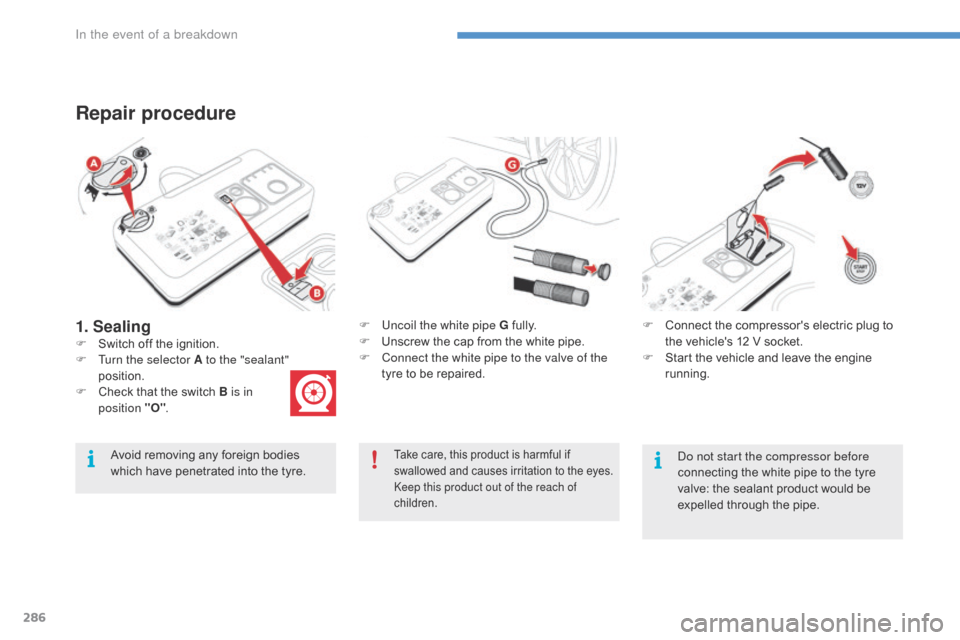
286
C4-Picasso-II_en_Chap08_en-cas-panne_ed01-2016
1. Sealing
Repair procedure
Avoid removing any foreign bodies which have penetrated into the tyre.F
U
ncoil the white pipe G
f
ully.
F
U
nscrew the cap from the white pipe.
F
C
onnect the white pipe to the valve of the
tyre to be repaired.
F
S
witch off the ignition.
F
T
urn the selector A to the "sealant"
position.
F
C
heck that the switch B is in
position "O" . F
C
onnect the compressor's electric plug to
t
he vehicle's 12 V socket.
F
S
tart the vehicle and leave the engine
r
unning.Take care, this product is harmful if s
wallowed and causes irritation to the eyes.
Keep this product out of the reach of
children.Do not start the compressor before
connecting the white pipe to the tyre
v
alve: the sealant product would be
e
xpelled through the pipe.
In the event of a breakdown
Page 292 of 527
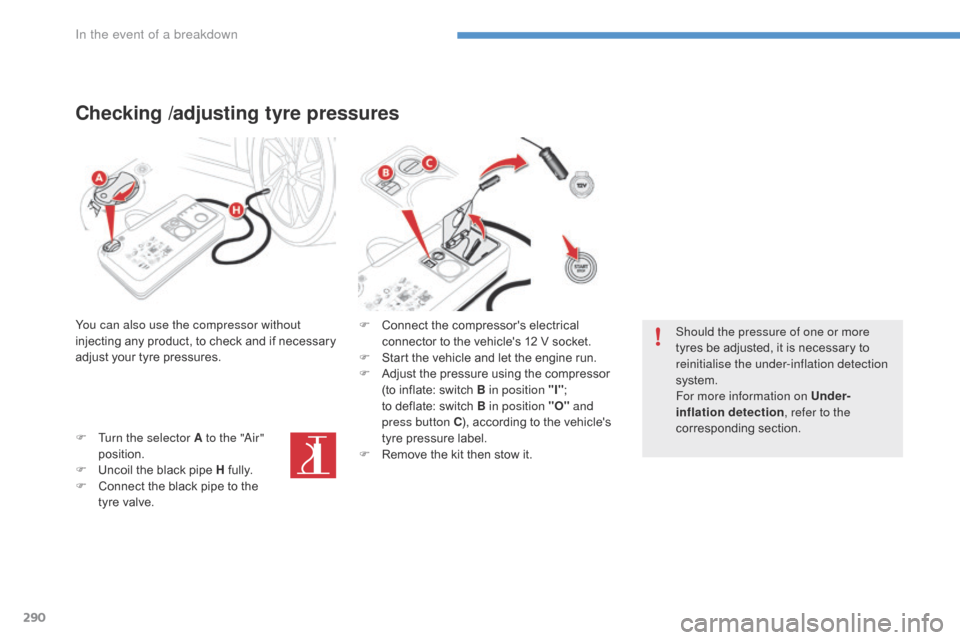
290
C4-Picasso-II_en_Chap08_en-cas-panne_ed01-2016
Checking /adjusting tyre pressures
You can also use the compressor without
injecting any product, to check and if necessary
a
djust your tyre pressures.
F
T
urn the selector A to the "Air"
position.
F
U
ncoil the black pipe H
f
ully.
F
C
onnect the black pipe to the
t
yre valve. F
C onnect the compressor's electrical
c
onnector to the vehicle's 12 V socket.
F
S
tart the vehicle and let the engine run.
F
A
djust the pressure using the compressor
(
to inflate: switch B in position "I";
t
o deflate: switch B in position "O" and
press button C ),
according to the vehicle's
t
yre pressure label.
F
R
emove the kit then stow it.Should the pressure of one or more
tyres
be adjusted, it is necessary to
r
einitialise the under-inflation detection
system.
For more information on Under-
inflation detection , refer to the
corresponding
s
ection.
In the event of a breakdown
Page 316 of 527
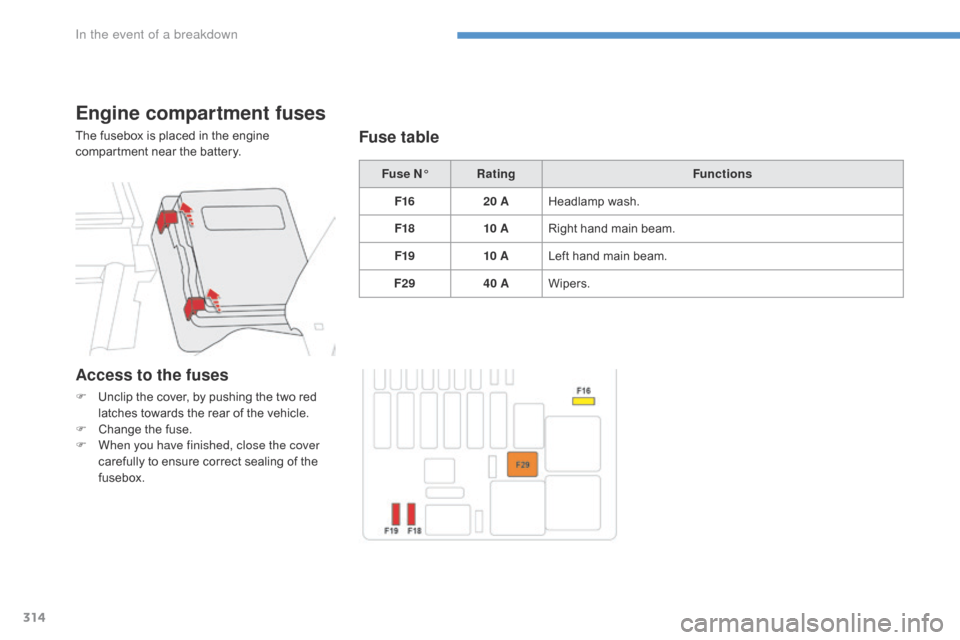
314
C4-Picasso-II_en_Chap08_en-cas-panne_ed01-2016
Engine compartment fuses
The fusebox is placed in the engine compartment near the battery.
Fuse N°Rating Functions
F16 20 AHeadlamp
w
ash.
F18 10 ARight
hand main beam.
F19 10 ALeft
hand main beam.
F29 40 AWipers.Fuse table
Access to the fuses
F Unclip the cover, by pushing the two red l
atches towards the rear of the vehicle.
F
C
hange the fuse.
F
W
hen you have finished, close the cover
carefully
to ensure correct sealing of the
f
usebox.
In the event of a breakdown
Page 317 of 527
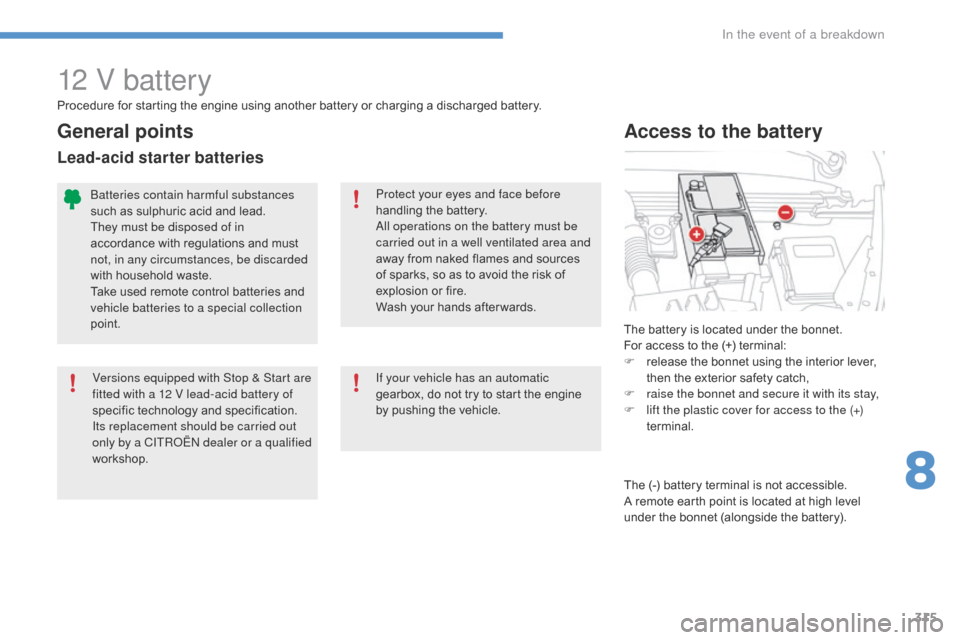
315
C4-Picasso-II_en_Chap08_en-cas-panne_ed01-2016
12 V battery
The battery is located under the bonnet.
F or access to the (+) terminal:
F
r
elease the bonnet using the interior lever,
t
hen the exterior safety catch,
F
r
aise the bonnet and secure it with its stay,
F
l
ift the plastic cover for access to the (+)
terminal.
Access to the battery
Procedure for starting the engine using another battery or charging a discharged battery.
P rotect your eyes and face before
handling
the battery.
All operations on the battery must be
carried out in a well ventilated area and
away
from naked flames and sources
o
f sparks, so as to avoid the risk of
e
xplosion or fire.
Wash
your hands after wards.
Versions equipped with Stop & Start are
fitted with a 12 V lead-acid battery of
specific
t
echnology
a
nd
s
pecification.
Its replacement should be carried out
only by a CITROËN dealer or a qualified
workshop.
Batteries contain harmful substances
such
as sulphuric acid and lead.
They must be disposed of in
accordance
with regulations and must
n
ot, in any circumstances, be discarded
with
household waste.
Take
used remote control batteries and
v
ehicle batteries to a special collection
point.
General points
Lead-acid starter batteries
If your vehicle has an automatic
gearbox, do not try to start the engine
b
y pushing the vehicle.
The
(-) battery terminal is not accessible.
A r
emote earth point is located at high level
u
nder the bonnet (alongside the battery).
8
In the event of a breakdown
Page 318 of 527
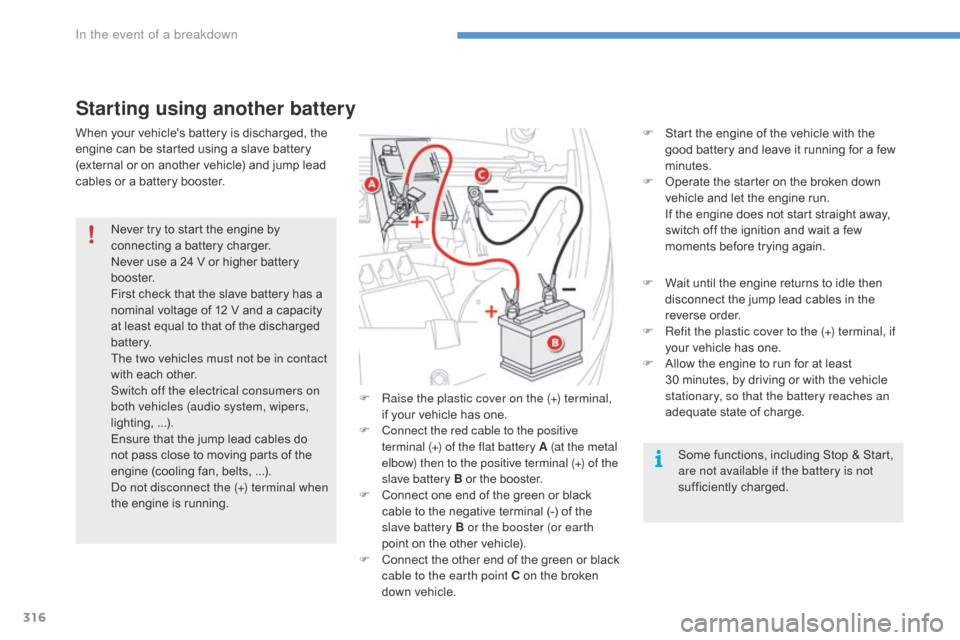
316
C4-Picasso-II_en_Chap08_en-cas-panne_ed01-2016
F Start the engine of the vehicle with the g
ood battery and leave it running for a few
m
inutes.
F
O
perate the starter on the broken down
v
ehicle and let the engine run.
I
f the engine does not start straight away,
s
witch off the ignition and wait a few
m
oments before trying again.
F
W
ait until the engine returns to idle then
d
isconnect the jump lead cables in the
r
everse
o
rder.
F
R
efit the plastic cover to the (+) terminal, if
your
vehicle has one.
F
A
llow the engine to run for at least
3
0 minutes, by driving or with the vehicle
s
tationary, so that the battery reaches an
adequate
state of charge.
Starting using another battery
Some functions, including Stop & Start, are not available if the battery is not
sufficiently
c
harged.
F
R
aise the plastic cover on the (+) terminal,
if
your
vehicle
has
one.
F
C
onnect the red cable to the positive
terminal (+) of the flat battery A (at the metal
elbow) then to the positive terminal
(+) of the
slave battery B
or
the
booster.
F
C
onnect
one
end
of
the
green
or
black
c
able
to
the
negative
terminal
(-)
of
the
s
lave battery B or the booster (or earth
point
on
the
other
vehicle).
F
C
onnect
t
he
o
ther
e
nd
o
f
t
he
g
reen
o
r
b
lack
c
able to the earth point C
on
the
broken
d
own
vehicle.
Never
try
to
start
the
engine
by
c
onnecting
a
battery
charger.
Never
use
a
24
V
or
higher
battery
b
o o s t e r.
First
check
that
the
slave
battery
has
a
n
ominal
voltage
of
12
V
and
a
capacity
a
t
least
equal
to
that
of
the
discharged
b
attery.
The two vehicles must not be in contact
with
each
other.
Switch off the electrical consumers on
both vehicles (audio system, wipers,
lighting, ...).
Ensure
that
the
jump
lead
cables
do
n
ot
pass
close
to
moving
parts
of
the
e
ngine
(cooling
fan,
belts, ...).
Do not disconnect the (+) terminal when
the
engine
is
running.
When
your
vehicle's
battery
is
discharged,
the
e
ngine
can
be
started
using
a
slave
battery
(
external
or
on
another
vehicle)
and
jump
lead
c
ables
or
a
battery
booster.
In the event of a breakdown
Page 320 of 527

318
C4-Picasso-II_en_Chap08_en-cas-panne_ed01-2016
The Stop & Start system may not be
operational during the trip following the
f
irst engine start.
In this case, the system will only be
available
again after a continuous
p
eriod of immobilisation of the vehicle,
a period which depends on the ambient
temperature
and the state of charge of
t
he battery (up to about 8 hours).
Do
not
force
the
lever
as
locking
will
n
ot be possible if the clamp is not
positioned
correctly;
start
the
procedure
ag
ain.
Disconnecting the (+) terminal
F
Ra
ise the lever A fully to release the
clamp
B
.
Reconnecting the (+) terminal
F
P
osition the open clamp B of the cable on
the
positive
post
(+)
of
the
battery.
F
P
ress down on the clamp to position it
correctly
on
the
battery
post.
F
L
ock
the
clamp
by
lowering
the
lever
A .
Disconnecting the battery
In order to maintain an adequate state
of
charge for starting the engine, it is
r
ecommended that the battery be disconnected
if
the vehicle is taken out of service for a long
p
eriod.
Before
disconnecting the battery:
F
c
lose all openings (doors, boot, windows,
r
oof),
F
s
witch off all electrical consumers (audio
system,
wipers, lighting, ...),
F
s
witch off the ignition and wait for four
m
inutes.
At
the battery, detach just the (+) terminal.Following reconnection of the battery
Following reconnection of the battery, switch on the ignition and wait 1 minute before starting to
p
ermit initialisation of the electronic systems.
H
owever, if problems remain following this
o
peration, contact a CITROËN dealer or a
qualified
w
orkshop.
Referring
to the corresponding section, you
m
ust
y
ourself
r
einitialise
(
depending
o
n
ve
rsion):
-
t
he remote control key,
-
t
he electric blind(s),
-
...
Quick release terminal
In the event of a breakdown
Page 321 of 527
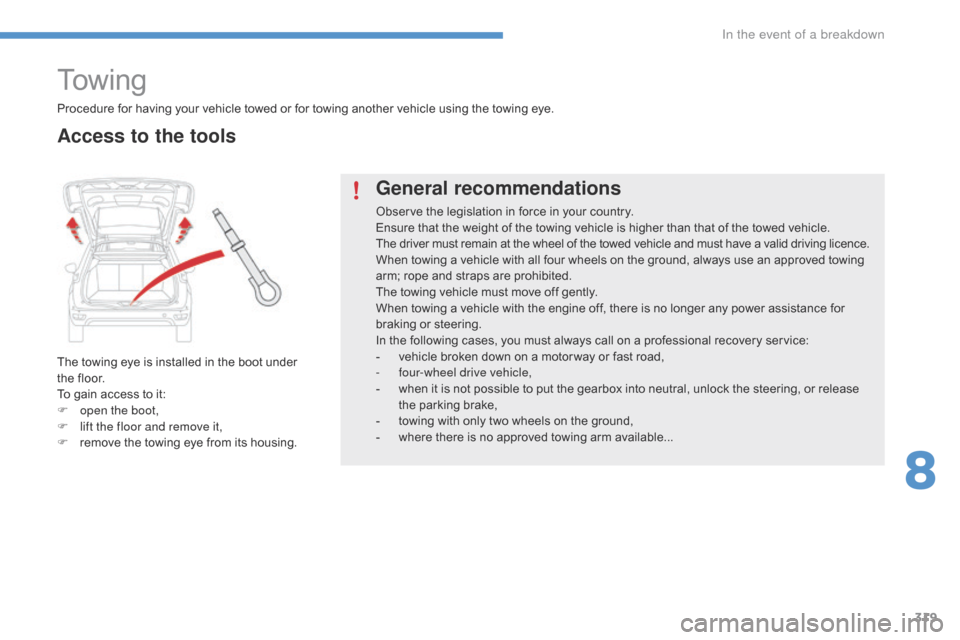
319
C4-Picasso-II_en_Chap08_en-cas-panne_ed01-2016
To w i n g
The towing eye is installed in the boot under the floor.
To
gain access to it:
F
o
pen the boot,
F
l
ift the floor and remove it,
F
r
emove the towing eye from its housing.
General recommendations
Observe the legislation in force in your country.
E nsure that the weight of the towing vehicle is higher than that of the towed vehicle.
The
driver must remain at the wheel of the towed vehicle and must have a valid driving licence.
When
towing a vehicle with all four wheels on the ground, always use an approved towing
a
rm; rope and straps are prohibited.
The
towing vehicle must move off gently.
When
towing a vehicle with the engine off, there is no longer any power assistance for
b
raking or steering.
In
the following cases, you must always call on a professional recovery service:
-
v
ehicle broken down on a motor way or fast road,
-
f
our-wheel drive vehicle,
-
w
hen it is not possible to put the gearbox into neutral, unlock the steering, or release
t
he parking brake,
-
t
owing with only two wheels on the ground,
-
w
here there is no approved towing arm available...
Procedure
for
having
your
vehicle
towed
or
for
towing
another vehicle using the towing eye.
Access to the tools
8
In the event of a breakdown
Page 322 of 527
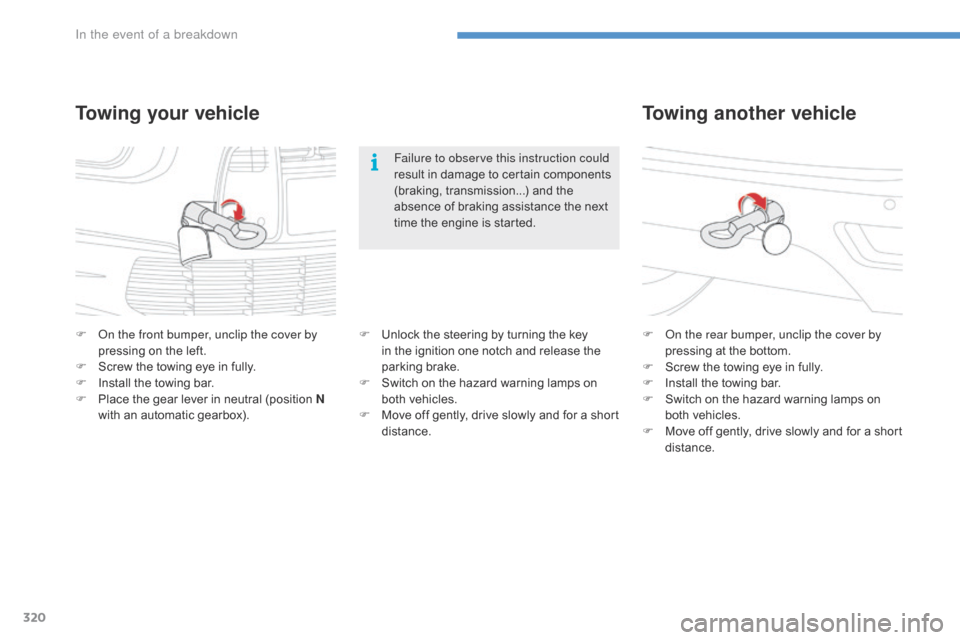
320
C4-Picasso-II_en_Chap08_en-cas-panne_ed01-2016
Towing another vehicle
F On the rear bumper, unclip the cover by pressing at the bottom.
F
S
crew the towing eye in fully.
F
I
nstall the towing bar.
F
S
witch on the hazard warning lamps on
b
oth vehicles.
F
M
ove off gently, drive slowly and for a short
di
stance.
F
O
n the front bumper, unclip the cover by
pressing
on
the
left.
F
S
crew
the
towing
eye
in
fully.
F
I
nstall
the
towing
bar.
F
P
lace
the
gear
lever
in
neutral
(position
N
with
an
automatic
gearbox).
Towing your vehicle
Failure to observe this instruction could
result in damage to certain components
(
braking, transmission...) and the
a
bsence of braking assistance the next
t
ime the engine is started.
F
U
nlock the steering by turning the key
i
n
the ignition one notch and release the
par
king
b
rake.
F
S
witch on the hazard warning lamps on
b
oth vehicles.
F
M
ove off gently, drive slowly and for a short
di
stance.
In the event of a breakdown
Page 323 of 527
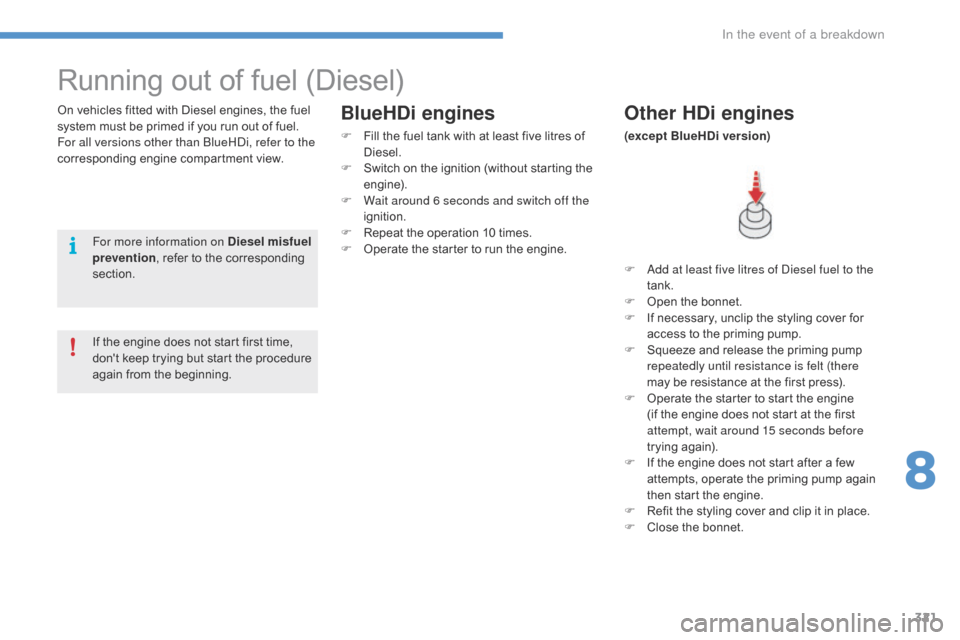
321
C4-Picasso-II_en_Chap08_en-cas-panne_ed01-2016
Running out of fuel (Diesel)
On vehicles fitted with Diesel engines, the fuel system must be primed if you run out of fuel.
For all versions other than BlueHDi, refer to the
corresponding
engine compartment view.Other HDi engines
(except BlueHDi version)
For more information on Diesel misfuel
prevention ,
refer
to
the
corresponding
s
ection.
If
the
engine
does
not
start
first
time,
d
on't
keep
trying
but
start
the
procedure
a
gain
from
the
beginning.
BlueHDi engines
F Fill the fuel tank with at least five litres of D
iesel.
F
S
witch on the ignition (without starting the
e
ngine).
F
W
ait around 6 seconds and switch off the
ignition.
F
R
epeat the operation 10 times.
F
O
perate the starter to run the engine.F
A
dd at least five litres of Diesel fuel to the
tank.
F
O
pen the bonnet.
F
I
f necessary, unclip the styling cover for
a
ccess to the priming pump.
F
S
queeze and release the priming pump
r
epeatedly until resistance is felt (there
may
be resistance at the first press).
F
O
perate the starter to start the engine
(
if the engine does not start at the first
a
ttempt, wait around 15 seconds before
trying
ag
ain).
F
I
f the engine does not start after a few
a
ttempts, operate the priming pump again
t
hen start the engine.
F
R
efit the styling cover and clip it in place.
F
C
lose the bonnet.
8
In the event of a breakdown
Page 324 of 527
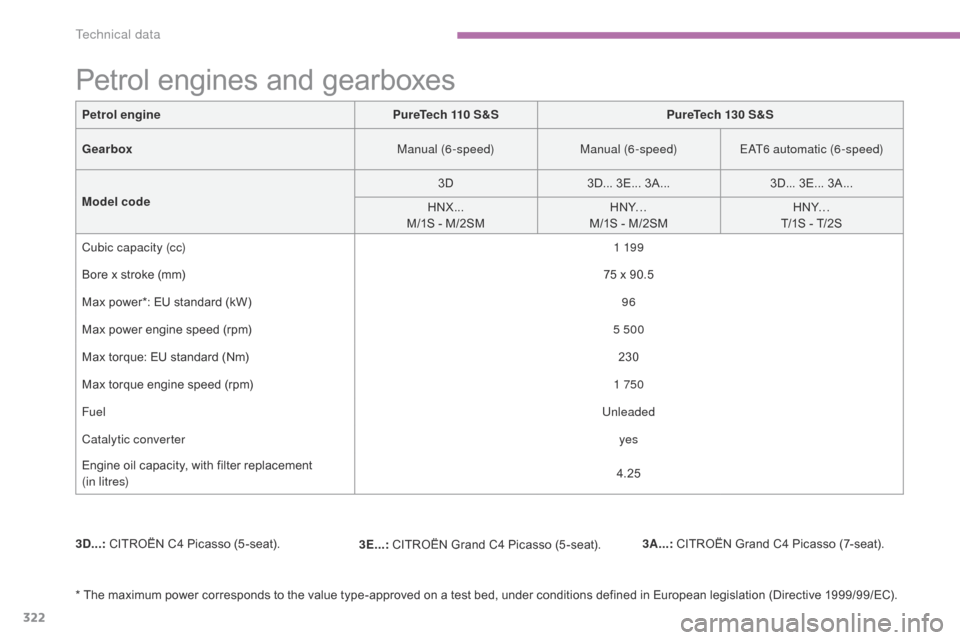
322
C4-Picasso-II_en_Chap09_caracteristiques-techniques_ed01-2016
Petrol enginePureTech 110 S&SPureTech 130 S&S
Gearbox Manual (6-speed)Manual (6-speed)EAT6 automatic (6-speed)
Model code 3D
3D...
3
E...
3
A...3D...
3
E...
3
A...
HNX...
M/1S
- M/2SMHNY…
M/1S
- M/2SMHNY…
T/1S
- T/2S
Cubic capacity (cc) 1 19 9
Bore
x stroke (mm) 75
x 90.5
Max
power*: EU standard (kW) 96
Max
power engine speed (rpm) 5 500
Max
torque: EU standard (Nm) 230
Max
torque engine speed (rpm) 1 750
Fuel Unleaded
Catalytic converter yes
Engine
oil capacity, with filter replacement
(in litres) 4.25
Petrol engines and gearboxes
3D...:
CITROËN C4 Picasso (5 -seat). 3A...: CITROËN Grand C4 Picasso (7-seat).
3E...: CITROËN Grand C4 Picasso (5 -seat).
* The
maximum power corresponds to the value type-approved on a test bed, under conditions defined in European legislation (Directive 1999/99/EC).
Technical data